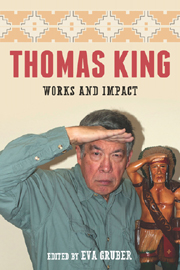Book contents
- Frontmatter
- Contents
- Preface
- Introduction
- Part 1 Works
- 1 Thomas King's Abo-Modernist Novels
- 2 “Wide-Angle Shots”: Thomas King's Short Fiction and Poetry
- 3 “Turtles All the Way Down”: Literary and Cultural Criticism, Coyote Style
- 4 Thomas King Meets Indigenous Convergent Media
- 5 Rewriting Genre Fiction: The DreadfulWater Mysteries
- 6 “All My Relations”: Thomas King's Coyote Tetralogy for Kids
- Part 2 Impact
- Part 3 Approaches
- Part 4 Encounters
- Part 5 Thomas King—A Bibliography
- Notes on the Contributors
- Index
6 - “All My Relations”: Thomas King's Coyote Tetralogy for Kids
from Part 1 - Works
Published online by Cambridge University Press: 05 February 2013
- Frontmatter
- Contents
- Preface
- Introduction
- Part 1 Works
- 1 Thomas King's Abo-Modernist Novels
- 2 “Wide-Angle Shots”: Thomas King's Short Fiction and Poetry
- 3 “Turtles All the Way Down”: Literary and Cultural Criticism, Coyote Style
- 4 Thomas King Meets Indigenous Convergent Media
- 5 Rewriting Genre Fiction: The DreadfulWater Mysteries
- 6 “All My Relations”: Thomas King's Coyote Tetralogy for Kids
- Part 2 Impact
- Part 3 Approaches
- Part 4 Encounters
- Part 5 Thomas King—A Bibliography
- Notes on the Contributors
- Index
Summary
In her introduction to Troubling Tricksters: Revisioning Critical Conversations, Kristina Fagan sums up trends in trickster studies, beginning in the late 1990s, when the trickster was a particularly fashionable topic in literary criticism on Aboriginal writing. In this early phase, Fagan emphasizes, most critics understood the figure as a timeless manifestation of “Indigenous tradition”: “From this perspective, we can see the pan-tribal trickster archetype offered a way of managing the issue of Indigenous ‘difference’ without requiring extensive research into the complexity of particular Indigenous peoples” (Fagan 2010, 5). Thus, in this incarnation, the trickster became whatever the critic wanted. Seeming to embody the ideals of ambiguity, disorder, and instability, it especially became a metaphor for postmodernism (6). In one of the contributions to Troubling Tricksters, Niigonwedom James Sinclair outlines how postmodernist approaches, often wielded in studies of Thomas King, “use a righteous liberal rhetoric to argue a totalizing postmodern cultural relativism and to claim that tricksters are the ultimate global trope: a figure that knows no home, has no responsibilities, and transgresses all boundaries” (Sinclair 2010, 28).
Recently, however, with the volume Troubling Tricksters leading the way, Aboriginal critics have initiated a rethinking of tricksters through a perspective shaped by the Indigenous Literary Nationalism movement. Calling for ethical and responsible criticism that adheres to cultural and historical specificity, this approach, when it comes to the trickster, requires us to pay attention to tribal history but at the same time consider how Aboriginal writers use the figure to suit their own purposes in the present.
- Type
- Chapter
- Information
- Thomas KingWorks and Impact, pp. 98 - 110Publisher: Boydell & BrewerPrint publication year: 2012

